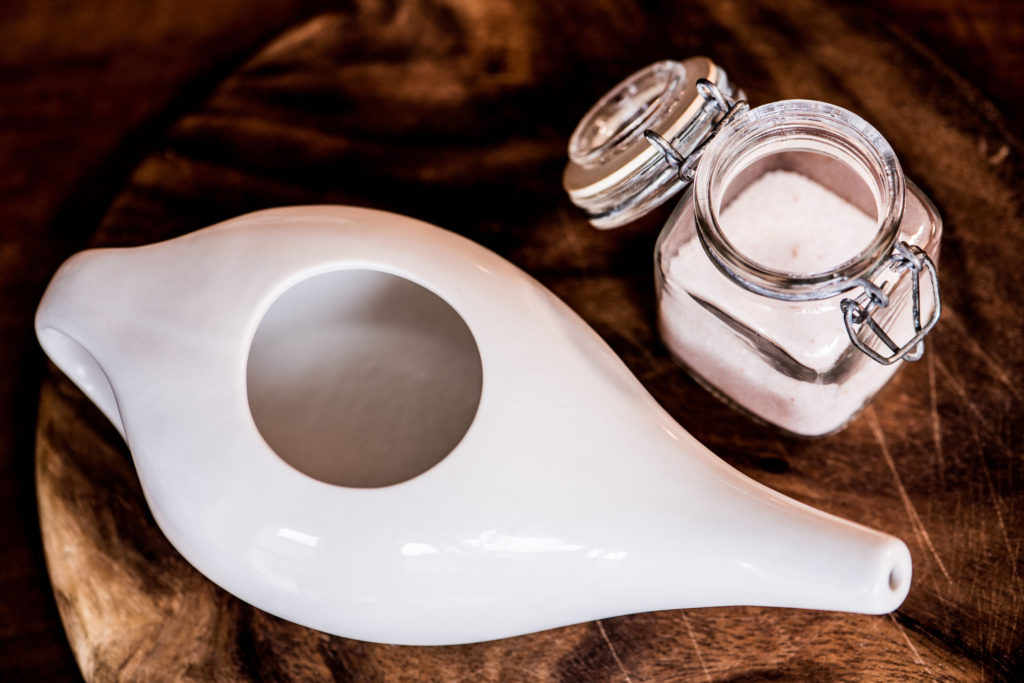
Spring has sprung! As trees, grasses, and flowers emerge in all their glory after the long winter, many people experience seasonal allergies. Whether your symptoms are mild or more bothersome, Neti pot (or nasal wash) can provide much relief.
The Neti pot has been used for thousands of years in the practice of Ayurveda to support healthy sinus function. In Sanskrit, “Neti” means “water cleansing.” Done regularly, it takes just a few minutes and easily becomes a part of daily personal hygiene. I can’t recommend enough this simple and effective way for keeping the sinuses clear, particularly if you suffer from allergies. And if you don’t suffer from allergies, but are prone to colds, studies show that the use of a Neti pot can minimize the frequency.

Nasal wash devices are not all the same. Here are two common options.
- The classic Neti pot is a container shaped like an Aladdin’s lamp, with a long, tapered neck. After filling it with room-temperature water and a small amount of non-iodized salt (typically 1/4 teaspoon), you insert the tapered end into your nostril, lean over a sink, and tilt your head to one side. As you lift the Neti pot, gravity sends water into the nostril, which drains out of the other nostril, washing mucus, pollen, and other irritants away.
- Two products that work on a different principle are the NeilMed Sinus Rinse and the SinuCleanse Squeeze bottle. While the Neti pot works on the principle of gravity, squeeze bottles work on low positive pressure. Because you control the amount and volume of water entering the nostril, some find this method more effective in removing congestion. Another distinction is that your head is more vertical when using a squeeze bottle.
If you experience any pressure in your ears using a Neti pot or squeeze bottle, stop the rinse at once and get one-on-one guidance. For some people, any form of nasal irrigation can be difficult due to a deviated septum. In this case, see your doctor to determine if nasal washing is viable.
What to do if you feel like you’re dying
I write that tongue-in-cheek (so to speak). Using a nasal wash is not likely to kill you — but many people report difficulty learning how to do it comfortably. One client said, “I feel like I’m drowning!”
In the video resources on my website, there are short video demos for both the Neti pot and the NeilMed Sinsus Rinse. Check them out here.
Precautions in safely using nasal irrigation
What kind of water to use. A 2012 article in the NYTimes reported a rare but toxic infection linked to bacteria found in tap water in Louisiana. While these incidents are highly unusual, it was enough for the Food and Drug Administration to issue warnings about safe use of Neti pots. They now only recommend the use of distilled or filtered water. (Another strike against tap water: because it is treated, it is potentially irritating to delicate nasal tissues.)
If distilled or filtered water is unavailable, you can boil tap water and wait until it cools before using. Test the temperature of the water on the inside of your wrist to ensure that it is neither too hot nor too cold. A tepid temperature is best.
It’s all in the details. Here are a few helpful tips that I rarely see addressed.
- Follow directions as to the proper amount of salt for the pot or bottle. Too much salt can irritate the nostrils.
- Use non-iodized salt. The Neil-Med comes with pre-measured packets of salt for individual use.
- Breathe easily and calmly through your mouth while performing the nasal wash. At no point should you strain or feel deprived of oxygen.
- After you finish the nasal rinse on both sides, gently blow your nose – the operative word being “gentle.” (This applies any time you blow your nose.)
While you might feel more congested immediately following a nasal wash, you should begin to notice a marked improvement within about five minutes. Both Neti pots and squeeze bottles are inexpensive and can be found online or at your local Walgreens, CVS or Target.
Travel tips. Finally, as I travel frequently, I’ve found a few practices that help to keep my sinuses healthy. I carry a generic spray saline in my purse during the winter months and use it when my nostrils feel dry. It’s like a Neti rinse on-the-go. When traveling on planes, I also use pre-soaked Q-tips to discreetly coat the inside of my nostrils with either organic almond, coconut, or sesame oil. Oiling the nostrils in the months when indoor and outdoor temperatures are radically different – or when the nostrils begin to feel dry or crusted at any time of year – will help keep the nasal passages lubricated and clear.
Frequency.
If you are an allergy sufferer or you frequently get colds, try daily nasal rinsing and see if it doesn’t make a difference. For others, using the Neti pot sporadically throughout the year when experiencing congestion due to cold symptoms or during the height of allergy season can help a lot. For many, it can also alleviate the use of decongestives.
In the words of Gustav Mahler, “Spring won’t let me stay in this house any longer! I must get out and breathe the air deeply again.”
I use it twice a day and 3 times if sinus issue…travel…a larger bottle of saline spray so it has more pressure…as no neti traveling due to unfiltered water.
I tell newbe neti people..you. Will think after…oh, so this is breathing…and I wrote a song to the tune of…lollipop lollipop…Neti pot neti pot…oh neti. Neti, neti…Neti pot…(bend head down and pretend you are blowing nose into tissue 4 times to rhythm.)
Gail Spirit Sky
Thanks for you comments, Gail. Love the song. Cheers.